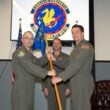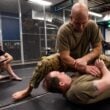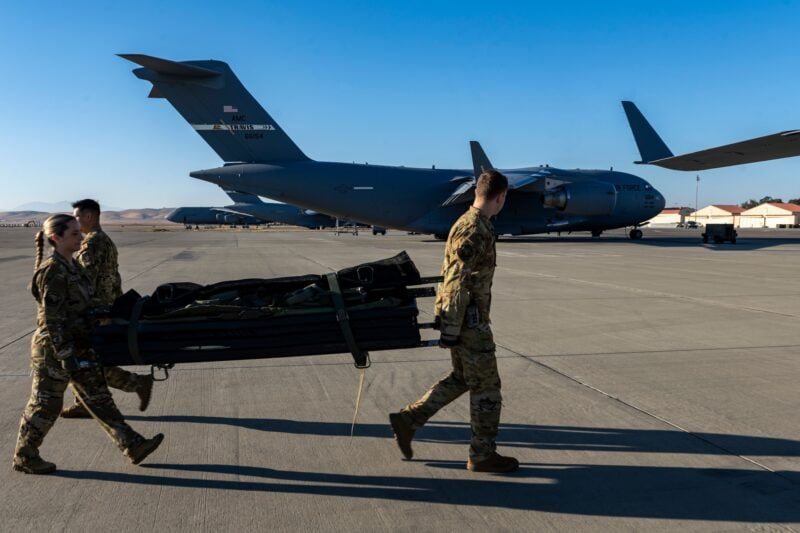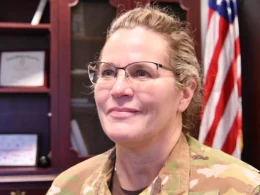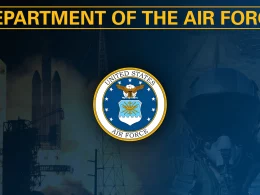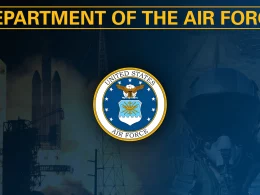TRAVIS AIR FORCE BASE, Calif. —
In a groundbreaking moment for Team Travis, the 60th Aeromedical Evacuation Squadron completed its first mission in which they were responsible for planning, launch and recovery and providing the crew for the mission, a milestone which demonstrated the readiness of the U.S. Air Force’s medical response capabilities.
The mission involved the mobilization of flight nurses, aeromedical evacuation technicians and aircrew members working together to safely transport patients to a variety of medical facilities. AE is a critical component of the Air Force’s medial support aimed at providing safe, efficient and rapid patient transport in both combat and peacetime environments.
“Our first mission was very successful and a great experience to be involved with,” said 1st Lt. Kailyn Keller, 60th AES flight nurse. “The mission provides our squadron with greater opportunities for hands-on patient care, allows our team to strengthen our clinical skills and knowledge and is an amazing opportunity to make a difference for our community, fellow service members and their families.”
After landing at Joint Base Pearl Harbor-Hickam, Hawaii, the 60th AES received a request to transport an additional critical patient, prompting the 15th Healthcare Operations Squadron Critical Care Air Transport Team to join the mission. CCATT, a specialized team comprised of a physician, a nurse and a respiratory therapist, provided enhanced capabilities for handling complex patients requiring intensive care.
The AE crew members were responsible for providing in-flight care, keeping patients stabilized and ready to continue their treatment once they reached their destinations. From medical personnel monitoring patients’ vital signs to aircrew ensuring flight safety and comfort, each team member played a crucial role.
“Our patients were safely and effectively transferred to their next level of care,” said 1st Lt. Trung Tran, 60th AES flight nurse. “AE lives in a very fluid environment, and our crew had the pleasure of experiencing that first-hand. The original plan called for a quick out-and-back to Hawaii but turned into an extended mission which took us across the country to Washington D.C. and back to Travis AFB over the span of four days.”
The mission was carried out on a C-17 Globemaster III assigned to the 60th Air Mobility Wing, which provides ample space allowing both the AES and CCATT teams to work side by side. The mission underscored the expertise within each team as they adjusted and worked together, proving the AE team’s ability to handle varying scenarios at a moment’s notice.
“Our first mission was a success,” said Tran. “Our crew had the opportunity to work alongside the Hickam CCATT, which was an invaluable experience as the crew was able to apply all of our training, ensuring a smooth transition of the WESTPAC mission.”
The 775th Aeromedical Evacuation Squadron, who previously deployed to Travis for six months at a time, decommissioned. The mission will be completely absorbed by the 60th AES. The 60th AES is the largest squadron in the Air Mobility Command, and one of four active-duty squadrons. This changeover will allow the 60th AES to further their reach, increasing the patient movement throughout the Pacific Air Forces.
“Taking over the Western Pacific mission enables our members to enhance deployment preparedness,” said Senior Airman Lainy Button, 60th AES aeromedical evacuation technician. “We collaborate with external entities including specialty teams, Tanker Airlift Control Center, Transportation Command Patient Movements Requirement Center and Aeromedical Staging Facility to ensure the successful launch and recovery on live missions.”




